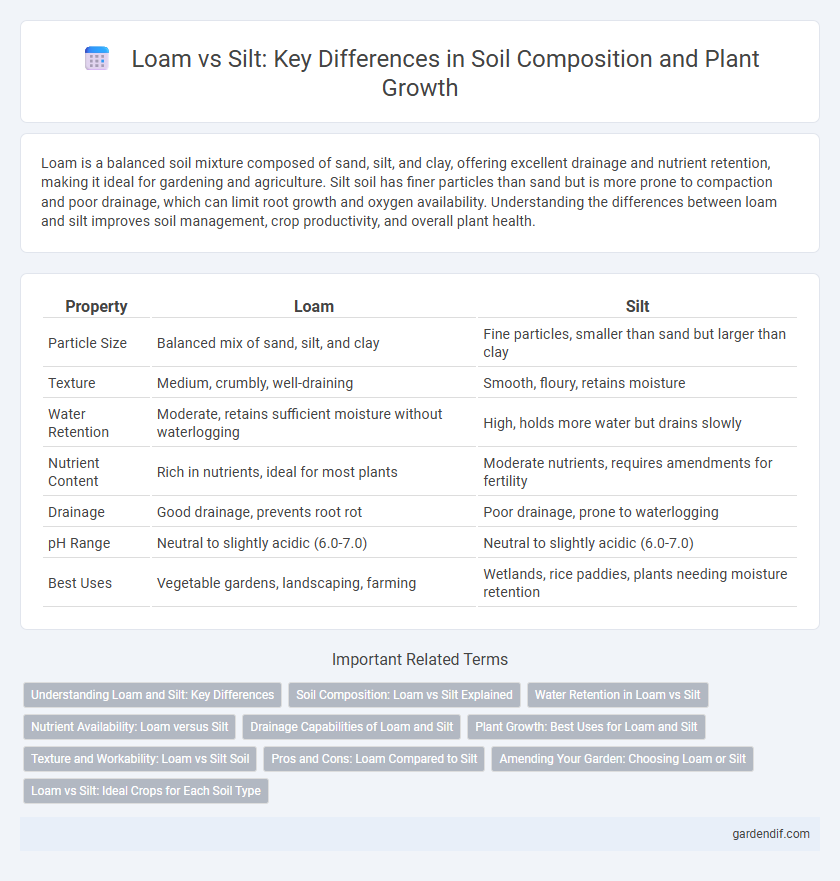
Loam vs Silt Illustration
Loam is a balanced soil mixture composed of sand, silt, and clay, offering excellent drainage and nutrient retention, making it ideal for gardening and agriculture. Silt soil has finer particles than sand but is more prone to compaction and poor drainage, which can limit root growth and oxygen availability. Understanding the differences between loam and silt improves soil management, crop productivity, and overall plant health.
Table of Comparison
| Property | Loam | Silt |
|---|---|---|
| Particle Size | Balanced mix of sand, silt, and clay | Fine particles, smaller than sand but larger than clay |
| Texture | Medium, crumbly, well-draining | Smooth, floury, retains moisture |
| Water Retention | Moderate, retains sufficient moisture without waterlogging | High, holds more water but drains slowly |
| Nutrient Content | Rich in nutrients, ideal for most plants | Moderate nutrients, requires amendments for fertility |
| Drainage | Good drainage, prevents root rot | Poor drainage, prone to waterlogging |
| pH Range | Neutral to slightly acidic (6.0-7.0) | Neutral to slightly acidic (6.0-7.0) |
| Best Uses | Vegetable gardens, landscaping, farming | Wetlands, rice paddies, plants needing moisture retention |
Understanding Loam and Silt: Key Differences
Loam is a balanced soil mixture containing roughly 40% sand, 40% silt, and 20% clay, offering optimal drainage and nutrient retention for plant growth. Silt soil, composed mainly of fine particles sized between sand and clay, retains moisture better but is prone to compaction and poor aeration. Understanding the key differences between loam and silt is essential for effective soil management and selecting suitable plants for specific environments.
Soil Composition: Loam vs Silt Explained
Loam soil is a balanced mixture of sand, silt, and clay, typically containing about 40% sand, 40% silt, and 20% clay, which provides excellent drainage and nutrient retention. Silt soil consists predominantly of fine particles between 0.002 and 0.05 mm, offering high water-holding capacity but poor drainage and aeration compared to loam. Understanding the distinct particle size distribution and texture of loam versus silt is essential for optimizing soil fertility and plant growth.
Water Retention in Loam vs Silt
Loam soil exhibits balanced water retention due to its blend of sand, silt, and clay particles, enabling adequate moisture availability for plants without waterlogging. Silt soil retains more water than loam because of its smaller particle size and higher surface area, resulting in slower drainage and prolonged moisture retention. However, excessive water retention in silt can lead to poor aeration and root oxygen deficiency compared to the well-draining properties of loam.
Nutrient Availability: Loam versus Silt
Loam soil offers superior nutrient availability compared to silt due to its balanced composition of sand, silt, and clay, which promotes optimal water retention and aeration. The higher organic matter content in loam enhances nutrient-holding capacity and microbial activity, essential for plant growth. Silt, while fine-textured and fertile, often suffers from poor drainage and compaction, limiting nutrient accessibility and root development.
Drainage Capabilities of Loam and Silt
Loam soil exhibits superior drainage capabilities due to its balanced composition of sand, silt, and clay, allowing adequate water retention while preventing waterlogging. Silt soil, with its fine particles, tends to retain more water and drain slower, often leading to poor aeration and potential root rot in plants. Effective drainage in loam supports healthier root development and reduces risks associated with excessive moisture compared to silt-dominant soils.
Plant Growth: Best Uses for Loam and Silt
Loam soil, composed of balanced sand, silt, and clay, offers excellent drainage and nutrient availability, making it ideal for most garden plants and crops. Silt soil retains moisture longer and is rich in nutrients but can compact easily, making it suitable for moisture-loving plants and certain vegetables like lettuce and spinach. Optimal plant growth is achieved by matching crop types with soil texture, where loam supports a wide variety of plants due to its aeration and fertility, while silt benefits plants requiring consistent moisture.
Texture and Workability: Loam vs Silt Soil
Loam soil features a balanced texture of sand, silt, and clay, providing excellent workability and drainage, making it ideal for most plants. Silt soil, composed primarily of fine particles, feels smooth but can become compacted easily, reducing aeration and workability. The loamy texture enhances root penetration and moisture retention better than the more compact and dense silt soil.
Pros and Cons: Loam Compared to Silt
Loam offers superior drainage and nutrient retention compared to silt, supporting healthier root growth and reducing the risk of waterlogging. Silt retains more moisture but can compact easily, leading to poor aeration and slower plant development. Loam's balanced texture provides an ideal environment for diverse crops, while silt requires careful management to prevent erosion and maintain fertility.
Amending Your Garden: Choosing Loam or Silt
Loam is ideal for garden soil amendment due to its balanced mixture of sand, silt, and clay, providing excellent drainage and nutrient retention for healthy plant growth. Silt, while finer and holding moisture well, can lead to poor drainage and compaction, making it less suitable as a primary amendatory material. Opting for loam enhances soil texture and fertility, promoting robust root development and sustained moisture availability.
Loam vs Silt: Ideal Crops for Each Soil Type
Loam soil, composed of balanced sand, silt, and clay, is ideal for vegetables such as tomatoes, carrots, and beans due to its excellent drainage and nutrient retention. Silt soil, characterized by fine particles and high water retention, supports crops like rice, wheat, and leafy greens that thrive in moisture-rich environments. Understanding the water-holding capacity and texture preferences of crops helps optimize planting strategies for loam versus silt soils.
Loam vs Silt Infographic

 gardendif.com
gardendif.com